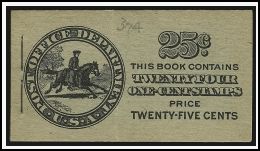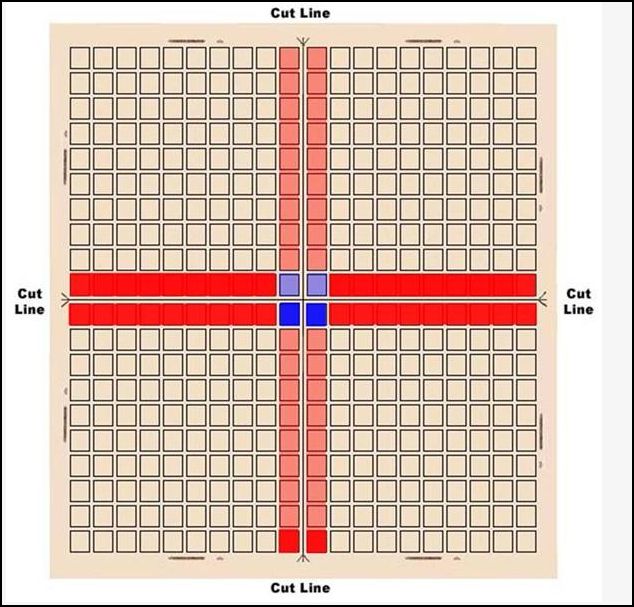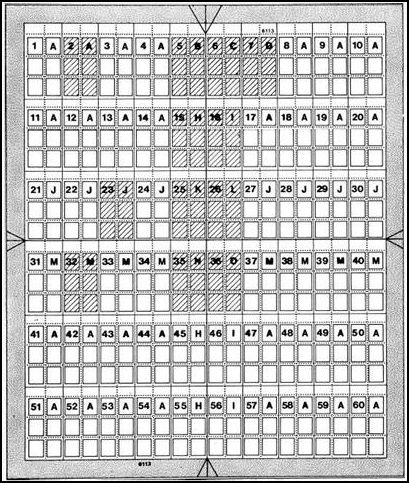a discussion on booklet panes and how they're made & printed
Dec 8, 2014 9:19:35 GMT
stampgeezer likes this
Post by I.L.S. on Dec 8, 2014 9:19:35 GMT
JUST SO IT'S PLAINLY KNOWN THIS INFORMATION WAS PUT TOGETHER BY A FELLOW SCF MEMBER "RUSS". He is very well known on many different stamp discussion boards and his information is very useful. the whole thread can be found by simply searching their site using the search string Booklet versus other stamps. Thank you.

Russ said:
"The difference between sheet and booklet stamps is basically how the panes are cut and perforated."
"Below is a typical layout for a 400 subject flat plate printing. The sheet consists of 4 panes of 100 separated by horizontal and vertical centerlines. The sheet is cut along the center-lines to produce 4 panes."

"Below is a typical layout for a 360 subject flat plate printing. The sheet consists of 60 booklet panes of 6. The sheet is cut along all 4 sides of the panes of 6."

Below is a booklet and booklet pane (Scott 374)


"As a booklet pane or a horizontal pair it is very distinguishable but the individual stamps would not be distinguishable from sheet stamps."
"There are a variety of printing method and sheet layouts that were used for both sheet and booklet stamps. The degree to which the individual stamps can be distinguished varies."

~~~~~~~~~~~~~~~~~~~~~~~~~~~~~~~~~~~~~~~~~~~~~~~~~~~~~~~~~~~~~~~~~~~~~~~~~~~~~~~~~~~~~~~~~~~~~~~~~~~~~~~~~~~~~
RUSS:
First, there are many different plate layouts for both the sheet panes and the booklet pane. These combinations result in considerable variance in the extent to which the booklet and sheet stamps can be differentiated.
Using the flat plate layouts shown above the perforations of each would be 11x11. Obviously all booklet pane singles would have at least one straight edge while the sheet pane (of 100) would only have 19 stamps with straight edges. The remaining 81 stamps from the sheet would be perforated on all 4 sides.
The positions shown in red would have one straight edge and those shown in blue would have two straight edges. The positions that may be distinguishable as either sheet or booklet are shown in a darker shade.
On the booklet panes the two positions above the horizontal arrow and the two positions left and right of the bottom vertical arrow can be cut in such a way where part of the angular arrowhead may be visible in the margin with a straight edge (positions 21-5, 30-6, 55-6 and 56-5). This is a combination that is only possible on the booklet panes.

On the sheet stamps the top row of the lower right and lower left panes will have a straight edge on the top which is not possible in the booklet stamps (positions 1-10LL and 1-10LR). This is a combination that is only possible on the sheet panes.
The bottom row of the upper right and upper left panes have nine positions per pane with a bottom straight edge and perforations on both vertical edges (positions 91-99UL and 92-100UR). This is a combination that is only possible on the sheet panes.
Additionally the two positions left and right of the bottom vertical arrow can be cut in such a way where part of the angular arrowhead may be visible in the margin with a perforated edge (positions 100LL and 91 LR). This is a combination that is only possible on the sheet panes.
~~~~~~~~~~~~~~~~~~~~~~~~~~~~~~~~~~~~~~~~~~~~~~~~~~~~~~~~~~~~~~~~~~~~~~~~~~~~~~~~~~~~~~~~~~~~~~~~~~~~~~~~~~~
Russ:
Another type of identifiable booklet pane single would be from the 180 subject sheets. These sheets contained 30 panes of 6. The panes from the center row had a guideline between the first and second row of stamps. This produced singles with a straight edge on one side and a guideline in the perforations at the top or bottom. This was n0t posible with sheet stamps

180 subject plate layout
Scott 300a Booklet pane with guideline.
This plate layout was used for booklet panes for Scott 300, 301, 319, 331, 332.
The rarest and most valuable U.S. booklet pane single is from a Scott 583a position J pane from plate 17451. The on cover example shown below is valued at $4000-$5000.


Russ said:
"The difference between sheet and booklet stamps is basically how the panes are cut and perforated."
"Below is a typical layout for a 400 subject flat plate printing. The sheet consists of 4 panes of 100 separated by horizontal and vertical centerlines. The sheet is cut along the center-lines to produce 4 panes."

"Below is a typical layout for a 360 subject flat plate printing. The sheet consists of 60 booklet panes of 6. The sheet is cut along all 4 sides of the panes of 6."

Below is a booklet and booklet pane (Scott 374)


"As a booklet pane or a horizontal pair it is very distinguishable but the individual stamps would not be distinguishable from sheet stamps."
"There are a variety of printing method and sheet layouts that were used for both sheet and booklet stamps. The degree to which the individual stamps can be distinguished varies."

~~~~~~~~~~~~~~~~~~~~~~~~~~~~~~~~~~~~~~~~~~~~~~~~~~~~~~~~~~~~~~~~~~~~~~~~~~~~~~~~~~~~~~~~~~~~~~~~~~~~~~~~~~~~~
RUSS:
First, there are many different plate layouts for both the sheet panes and the booklet pane. These combinations result in considerable variance in the extent to which the booklet and sheet stamps can be differentiated.
Using the flat plate layouts shown above the perforations of each would be 11x11. Obviously all booklet pane singles would have at least one straight edge while the sheet pane (of 100) would only have 19 stamps with straight edges. The remaining 81 stamps from the sheet would be perforated on all 4 sides.
The positions shown in red would have one straight edge and those shown in blue would have two straight edges. The positions that may be distinguishable as either sheet or booklet are shown in a darker shade.
On the booklet panes the two positions above the horizontal arrow and the two positions left and right of the bottom vertical arrow can be cut in such a way where part of the angular arrowhead may be visible in the margin with a straight edge (positions 21-5, 30-6, 55-6 and 56-5). This is a combination that is only possible on the booklet panes.

On the sheet stamps the top row of the lower right and lower left panes will have a straight edge on the top which is not possible in the booklet stamps (positions 1-10LL and 1-10LR). This is a combination that is only possible on the sheet panes.
The bottom row of the upper right and upper left panes have nine positions per pane with a bottom straight edge and perforations on both vertical edges (positions 91-99UL and 92-100UR). This is a combination that is only possible on the sheet panes.
Additionally the two positions left and right of the bottom vertical arrow can be cut in such a way where part of the angular arrowhead may be visible in the margin with a perforated edge (positions 100LL and 91 LR). This is a combination that is only possible on the sheet panes.
~~~~~~~~~~~~~~~~~~~~~~~~~~~~~~~~~~~~~~~~~~~~~~~~~~~~~~~~~~~~~~~~~~~~~~~~~~~~~~~~~~~~~~~~~~~~~~~~~~~~~~~~~~~
Russ:
Another type of identifiable booklet pane single would be from the 180 subject sheets. These sheets contained 30 panes of 6. The panes from the center row had a guideline between the first and second row of stamps. This produced singles with a straight edge on one side and a guideline in the perforations at the top or bottom. This was n0t posible with sheet stamps

180 subject plate layout
Scott 300a Booklet pane with guideline.
This plate layout was used for booklet panes for Scott 300, 301, 319, 331, 332.
The rarest and most valuable U.S. booklet pane single is from a Scott 583a position J pane from plate 17451. The on cover example shown below is valued at $4000-$5000.
